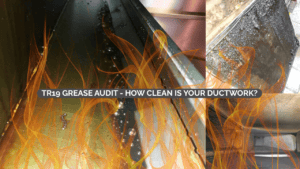By David Glover, Technical Director
When it comes to fire safety in commercial buildings, fire damper testing is one of the most overlooked — yet critically important — areas of compliance. Whether you’re a landlord managing a shopping mall, an FM company responsible for multiple office buildings, or the owner/operator of a commercial space, understanding your legal responsibilities around fire damper maintenance isn’t optional. It’s a legal requirement under the Regulatory Reform (Fire Safety) Order 2005.
And yet, time and again, I visit buildings where fire dampers haven’t been inspected in years — or worse, were never located or recorded in the first place.
So let’s break down why fire damper testing matters, what the regulations say, and how to ensure your building remains safe and compliant.
What is a Fire Damper?
Fire dampers are passive fire protection systems installed in ductwork where it passes through fire-rated walls or floors. Their purpose is simple: in the event of a fire, they close automatically to prevent flames and smoke from spreading through the ductwork, effectively compartmentalising the fire.
There are two main types:
- Mechanical fire dampers – typically held open with a fusible link that melts at around 72°C, causing the damper to close.
- Motorised (spring return or actuator-operated) fire dampers – triggered by the building’s fire alarm or smoke detection system.
Regardless of type, the principle is the same: a fire damper only works if it closes properly when needed.
Why Testing is Non-Negotiable
A fire damper that fails to close is a hidden danger. Unlike smoke detectors or alarms, it’s not immediately obvious if a fire damper is faulty — which is why routine fire damper inspection and testing is vital.
According to BS 9999:2017, all fire dampers should be:
- Located and logged in a fire damper register.
- Inspected and drop-tested at least every 12 months.
- Cleaned and lubricated where required to ensure functionality.
- Access panels should be installed if needed to facilitate testing.
Motorised dampers may require more frequent testing depending on manufacturer guidelines and risk assessments.
This isn’t just best practice — it’s enforceable by law under the Fire Safety Order, and failure to comply can lead to prosecution, fines, and — in the event of a serious fire — devastating legal and financial consequences.
Who’s Responsible?
For landlords, facilities management companies, and building owners, the key question is: who is the Responsible Person?
Under fire safety law, the Responsible Person is required to ensure that:
- Fire safety systems are maintained.
- Suitable records are kept.
- Fire risk assessments are regularly updated.
If you’re leasing space to commercial tenants — as in a shopping centre or shared office block — you still carry some responsibility, particularly for common areas and services such as HVAC.
Passing the buck is not an option.
Common Issues We See on Site
At Plasma Clean Air, we work with a wide range of commercial premises, and when it comes to fire damper compliance, here are some of the common issues we encounter:
- Incomplete or missing fire damper registers
- Dampers installed but with no access for testing
- Stuck or seized dampers due to poor maintenance
- Incorrect installation or poor labelling
- No records of previous testing
If any of these apply to your building, you may already be out of compliance.
The Cost of Non-Compliance
The penalties for failing to maintain fire safety systems can be severe. In recent years, several organisations have faced:
- Prosecution under the Fire Safety Order
- Fines in excess of £100,000
- Insurance claim complications in the event of fire
- Brand damage and loss of trust from tenants and occupants
Regular fire damper servicing isn’t just a checkbox exercise — it’s your protection against liability.
What a Fire Damper Test Involves
A compliant fire damper test typically includes:
- Location and identification of all dampers.
- Access and inspection, often requiring installation of access panels if not already present.
- Drop testing (for mechanical dampers) to ensure they close when the fusible link melts.
- Functional testing (for motorised dampers) to check operation via fire alarm integration.
- Cleaning, lubrication and remedials, where required.
- Reporting and photographic evidence, with an updated fire damper register provided.
Plasma Clean Air has a dedicated team of approved fire damper inspection engineers who can carry out a full survey, inspection, and drop testing to ensure your building remains compliant. Our service includes everything from identifying and logging dampers to functional testing and remedial recommendations — all in line with BS 9999:2017 and the Regulatory Reform (Fire Safety) Order 2005. We also install access panels where required to enable proper ongoing inspection.
Final Thoughts: Don’t Leave Fire Safety to Chance
As Technical Director, I cannot stress this enough: fire damper testing is a life safety issue.
It’s not just about ticking boxes for an audit — it’s about protecting lives, protecting property, and ensuring that your building is fit for purpose.
If you’re a landlord, facilities manager or commercial building owner, now is the time to take action:
✅ Audit your current fire damper register
✅ Schedule annual testing with a competent provider
✅ Ensure that remedials and access improvements are carried out
✅ Keep proper documentation for your fire risk assessment.
Ensure Fire Safety Compliance with Expert Support from Plasma Clean Air
For more information on how Plasma Clean Air can support your fire safety compliance through professional fire damper testing and inspection services, get in touch today. Let’s ensure your building is safe, compliant, and ready for inspection.
Let’s make sure your building is safe, compliant, and future-proofed.

